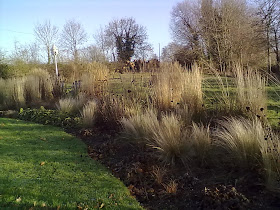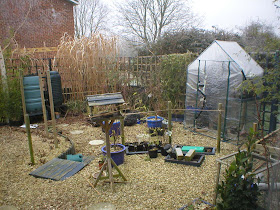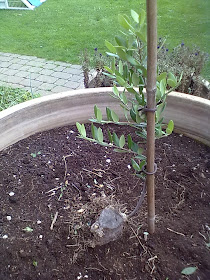Another subject that is dear to my heart - capturing and using rainwater, which is free, rather than expensive treated drinking water.
I was giving a client's water butt the annual dredging the other day, and I thought you might like to see it, as it's a bit of a lateral-thinking answer to a problem.
What was the problem? Well, three years ago there were two problems - firstly, next door's gutter was broken, so the water was making a mess on our side, and secondly, that end of the garden had no water supply, and I had just installed a set of three leaf mould pens which, being under the trees, were not going to receive any rain water.
I quickly realised that my client was unlikely to carry buckets of water all the way down the garden just to dampen the leaves, so I had to find a way to make it easy for them.
Asking the client gave the answer "I think there's an old butt somewhere", and a quick rootle around in the car port turned up an old water butt, and a short length of guttering. There are always plenty of old bricks around the garden, so I built up a nice stack of them, put the butt on top, and held the length of gutter up. Perfect! Now all I needed was a way to suspend the guttering so that it caught the water from the broken gutter, and directed it down into the butt.
The following week, I returned with a wire coat hanger from home, and a pair of pliers, and bingo!
Here's the top - you can see that next door's gutter has somehow shifted out of the joining bracket, and there is now a gap of about 4". (Errrr, 10cms. Sorry, I really will try to go metric....) It's a single-storey building, by the way, otherwise I would not have attempted it...
This top edge of my black gutter is propped up against the wall, and is leaning against the support bracket, which you can't quite see in this picture. It has been in place for two years now, and doesn't seem to need anything more to hold it there.
The bottom edge is supported inside the water butt by the wire coat hanger, bent in an S-shape to go up and over the edge of the butt.
At the business end, I have two lengths of old hosepipe, either of which can connect up to the tap - which, you may note with some amusement, is quite literally a kitchen tap......
One of these hoses is just long enough to run from the water butt to the leaf mould bins, which are just to the left, out of shot.
All we have to do is clip it on, turn the tap, and water the leaves. It's a very slow trickle, being just gravity fed, so I generally set it going, then go and work for 20 minutes or so.
The second hosepipe is the clever one, it runs around the back of the tree to the right, round the corner of the garden and slightly downhill to another water butt.
By the clever facility of syphoning, the water from this water butt can go and fill the second water butt, quite some distance away.
"Syphoning?" I hear you ask. Syphoning is the phenomenon whereby water, once you get it running along a hosepipe, will happily go uphill if the final destination is lower than the original height.
Shall I say that again?
It means that I can run a hose from the bottom of this butt, along the ground, UP and over the lip of another water butt at pretty much the same height, then down inside the butt. Once the water is flowing, it quite happily goes up and over, like a very small miracle. This means I can fill the second water butt, some distance away, to the same level as this water butt. Which means half full, of course. Then when this butt fills again, I open the tap and they equalise again. If it were raining steadily, and I left the tap open, they would both eventually fill to the top and overflow.
But it does mean that we now have two sources of water at the far end of the garden.
And yes, in case you are wondering, once this butt is full, it does overflow and splash around, just as it did before I installed it - but during the winter, when we don't need it, I slip a piece of plastic into the broken gutter, so that most of the water runs along it and down at the end into next door's drain, as it is supposed to.
While on the subject of syphoning, and "oh we haven't got room for one", here's a quick run-down of my own back garden's water collection system.
I had exactly the "oh, I haven't got room for one" problem: there was a down-pipe, but it was between the window on one side, and the pear tree on the other, so there was no-where to put a water butt.
My garden slopes slightly away from the house, so I installed a water butt at the far end of the garden, and experimented with a hosepipe.
You need an assistant for this game.... set up your water butt, then lay a hose-pipe from there to the downpipe. Hold your end of the hose at a comfortable height. Ask your assistant to hold their end of the hosepipe about a foot off the ground. Fill the hosepipe with water, until it comes out their end. Ask them to lift their end slowly until the water stops coming out. Continue to add water to your end - a jug is handy for this - and ask them to raise their end, until you have both of you holding the ends a metre or so off the ground, and both of you can see the water in the end of your hose.
You can now play a fun game of raising and lowering the ends, to observe how moving one end makes the water level change in the other end.
Now, you need to get the hosepipe arranged such that the water butt end is as high off the ground as the intake of the water butt. In my case, I had the water butt up on a stand, to allow filling of watering cans, so the overall height was about a metre and a half. (look at me, trying to be modern and metric! I am thinking "4' off the ground" but I'm trying to work in metres now...) Then you can see how high your rainwater diverter needs to be. In my case, it was about one metre off the ground, because the garden slopes away from the house.
There is no point putting the rainwater diverter in any higher, otherwise the water won't come back up the pipe once the butt is full. That's why you have to establish the level of the water butt first.
Having marked the downpipe to show where the rain diverter was to go, I then buried the hosepipe through the garden.
Here is one section, running through the courgette area, past the caged strawberries and the empty cold-frame. As it's shingle here, I am simply scraping back the shingle, putting the hose pipe in position over the membrane, and scraping the shingle back.
It's quite deep, just there, but I've been happily walking over it for a couple of years now, and it doesn't seem to have harmed the hose.
As I said, my garden slopes away from the house, so I had terraced it, using log roll edging to hold back the top terrace, and putting in two shallow steps in the middle.
To pass this obstacle, I had to dig a channel inside the log roll edging, dig a little tunnel underneath the bottom of the wood, and feed the hosepipe through it.
Yes, I had emptied out the water first.
I then tucked the hose under the shingle at the very base of the bottom step, where it was unlikely to be trodden on, and continued across the garden to the water butt.
If you try this, make sure you start with an overlong length of hosepipe, and leave plenty at each end, as the distance is just a little further when you bury the pipe.
On arrival at the end of the garden, I connected one end to the water butt, cutting off the excess: I then connected the other end to the rainwater diverter.
And it works perfectly!
So well, in fact, that I added another water butt down there - you can just see the two of them side by side on the far left of this picture, hiding behind the raspberry poles.
And there in the middle are the blue steps that we bypassed earlier.
As you can see, no sign of the hosepipe: at the house end I just have a neat diverter and a length of hose disappearing straight down. At the far end, the hose rises out of the ground and straight into the left-hand butt.
This ensures that I have plenty of water in the garden, and it's free water!
There, I hope that inspires you to have a go. If you have any questions, do feel free to ask.
Did you enjoy this article? Did you find it useful? Would you like me to answer your own, personal, gardening question? Become a Patron - just click here - and support me! Or use the Donate button for a one-off donation. If just 10% of my visitors gave me a pound a month, I'd be able to spend a lot more time answering all the questions!!












































